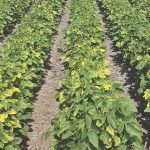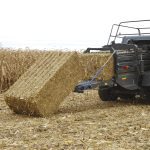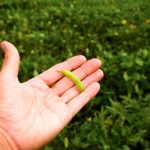Reading Time: 5 minutes It’s been 30 years since Canada’s regulatory system for plant breeding innovation was last reviewed, but since then, genetically modified organisms (GMO) technology has become an important feature. More recently, there have been advancements in gene editing such as with CRISPR Cas9, RNAi and epigenetics. These changes, among others, prompted a Health Canada review of […] Read more

The product, not the process
New rules for assessing novel foods could speed the arrival of better varieties for producers and consumers

Boron. An oft-forgotten (micro) nutrient for soybeans
Compared to other nutrients, soybeans need only a little, but how little is enough?
Reading Time: 5 minutes When it comes to fertilizer, many stick to the ABCs of N, P and K, perhaps with the addition of S (sulphur). But there is a growing recognition of the need for micronutrients such as boron in plant health and performance, especially for soybeans. Boron aids cell formation, cell wall and vascular tissue formation, node […] Read more

Manitoba soys are K-reluctant
Soybeans use a lot of potassium, but getting them to use it from added fertilizer is a bit of a challenge
Reading Time: 5 minutes Soybeans are now a regular crop in a Manitoba rotation, and since they use a lot of potassium, you’d think that it would make sense to provide them with enough to keep them happy. But a study funded by the Manitoba Pulse and Soybean Growers and Western Grains Research Foundation found little response to added […] Read more

Are corn and soybeans on the wane?
Could other crops erode their dominance in Eastern Canada, and if so, which ones?
Reading Time: 5 minutes In the next 10 to 30 years, could corn and soybeans became lesser crops in Ontario and Eastern Canada? What would that look like and how might that unfold? Before you say, “It’ll never happen,” think back to 1992 and changes such as transgenics, GPS and precision ag technologies and production capabilities that have virtually […] Read more

Impact of delayed post-emergence herbicide in soybean
#CropPatrol: Consider a two-pass treatment tailored to the weed spectrum in each field
Reading Time: 3 minutes The landscape for soybean production in Eastern Canada continues to evolve, influenced by newer cultivars, herbicide-resistant technologies and longer growing seasons. In 2021, Ontario growers planted more than 2.9 million acres of soybean, with a farm-gate value of nearly $1.5 billion. Despite these advances and the money at stake, growers still risk yield losses averaging […] Read more

An alternative cover crop for soybeans
Broadcast rye provides more management options and improves soil health
Reading Time: 5 minutes Agriculture has its share of innovators who set their own pace and adopt practices that initially have others shaking their heads. But then the new practice works, and they’re happy to share their experiences. That applies to Reuben Stone. Operating a farm value-added business near Cobden, Ont., Stone grows several specialty crops, including Daikon radish, […] Read more

Are your soybeans “O-K”?
Alpine agronomist says that soybeans respond remarkably well to late-season potassium applications
Reading Time: 4 minutes Steve McQueen says you should treat your soybeans like corn. No, not exactly the same, such as with split nitrogen applications or fungicides to thicken stalks or stems. But the agronomy manager for Alpine says growers could apply the same diligence to improving soybean performance as has become the norm in corn. McQueen says he’s […] Read more

Argentine growers who hold soybeans face higher financing costs
Reading Time: < 1 minute Buenos Aires | Reuters — Argentine soy farmers who hold onto stock of more than five per cent of their production will face an elevated financing cost above the normal benchmark rate, the South American country’s central bank said on Thursday, part of a wider push to encourage sales. The central bank said soy farmers […] Read more

StatCan trims Canadian corn, soy acreage estimates
Grain corn acreage still expected up from 2021 level
Reading Time: < 1 minute New Statistics Canada projections show the country’s grain corn and soybean growers have slightly curbed their enthusiasm for those crops compared to their intentions earlier in the year. StatCan on Tuesday released the results of its 2022 June field crop survey, conducted between May 13 and June 12, projecting Canadian corn area at 3.633 million […] Read more

U.S. soybean acres come in below expectations
Reading Time: 2 minutes MarketsFarm – Farmers in the United States seeded fewer soybean acres than original intentions and slightly more corn, according to updated acreage estimates from the U.S. Department of Agriculture, released June 30. Total soybean area in the country for the 2022 growing season was pegged at 88.30 million acres by the government agency. That compares […] Read more


